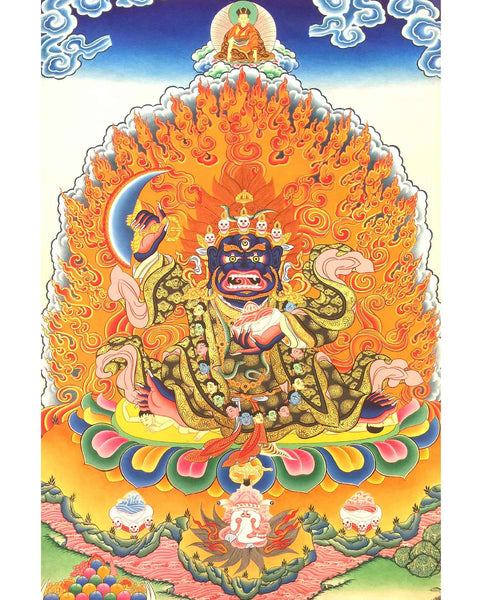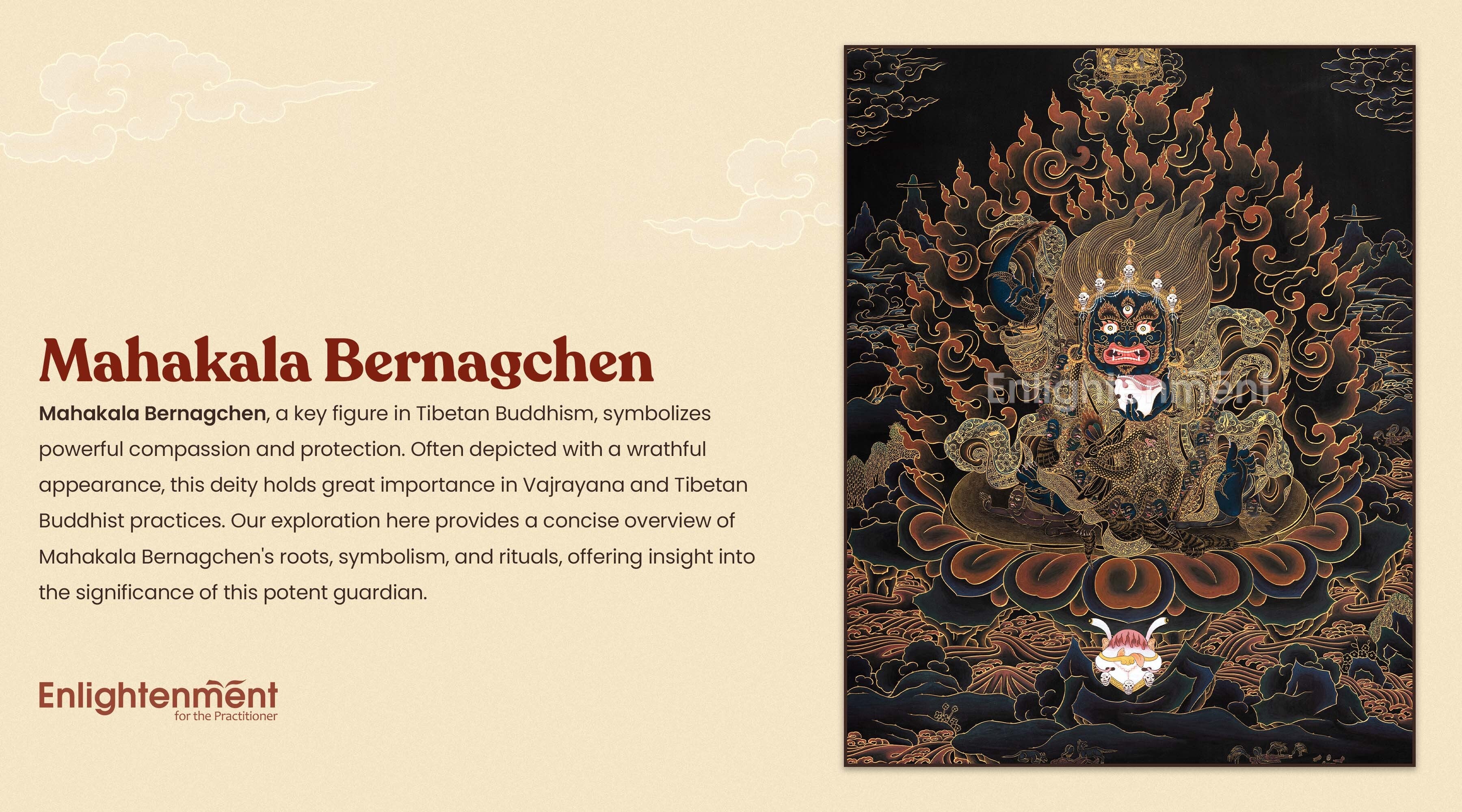Exploring the Mystical World of Mahakala Bernagchen
Mahakala Bernagchen, a prominent figure in Tibetan Buddhism, embodies a formidable manifestation of compassion and safeguarding. This deity, frequently portrayed with a wrathful demeanor, is pivotal in Vajrayana and Tibetan Buddhist practices. Our exploration here delves into the roots, symbolism, and rituals linked with Mahakala Bernagchen, providing a thorough insight into the significance of this potent guardian.
Key Takeaways
- Mahakala Bernagchen is a central figure in Tibetan Buddhism, representing a fierce aspect of compassion and protection.
- He is often depicted as a wrathful deity, signifying his power to eliminate obstacles and opposing forces.
- Mahakala Bernagchen profoundly connects with the Karma Kagyu lineage, particularly with the Karmapas.
- Various rituals and practices are associated with Mahakala Bernagchen to invoke his blessings and protection.
The Evolution of Mahakala in Buddhism
Click here to view Mahakala Bernagchen Statue
Mahakala's origins can be traced to Hinduism, where he manifested as an aspect of Shiva. As Buddhism expanded, Mahakala integrated into the Buddhist pantheon, transforming into a guardian deity. His role evolved to symbolize the eradication of ignorance and the safeguarding of the Dharma.
Mahakala Bernagchen in Tibetan Buddhism
Within Tibetan Buddhism, Mahakala assumes diverse forms, with Bernagchen as one of the most revered. Translating to "Black Coat," Bernagchen holds specific significance in the Karma Kagyu lineage. He serves as the primary protector of this school, sharing a unique connection with the Karmapas, who are the lineage heads.
| Period | Role In Buddhism | Connection with lineages |
| Early Buddhism | Minor Protector | General Buddhist Pantheon |
| Tibetan Buddhism | Major Protector Deity | Specifically Karma Kagyu |
Iconography and Attributes of Mahakala Bernagchen
Mahakala Bernagchen, a pivotal figure in Tibetan Buddhism, is esteemed for his dual role as a guardian and remover of obstacles. His iconography is laden with symbolism, conveying profound spiritual meanings and teachings.
Exploring the intricacies of Mahakala Bernagchen's iconography and attributes and his depiction in Tibetan thangka paintings provides valuable insight into his significance within Tibetan culture and religious observance.

Click here to view Mahakala Bernagchen Thangka
Wrathful Appearance
Mahakala Bernagchen is typically presented wrathfully, a common characteristic among Dharmapalas or protectors in Tibetan Buddhism. This fierce portrayal doesn't signify malevolence but underscores his capability to surmount obstacles and counter opposing forces obstructing spiritual advancement.
- Color: Depicted with dark blue or black skin, symbolizing the all-encompassing essence of compassion and the emptiness of phenomena.
- Facial Expression: His intense countenance, featuring bared fangs and a menacing gaze, signifies his unwavering commitment to eradicating ignorance and safeguarding the Dharma.
Physical Attributes
- Three Eyes: Mahakala Bernagchen is portrayed with three eyes, symbolizing his capacity to perceive the past, present, and future, embodying a comprehensive understanding across time.
- Flaming Hair: His hair is commonly depicted ablaze, signifying his potent energy and the purging of delusion.
- Crown of Skulls: Adorned with a crown of five skulls, he symbolizes the conversion of the five kleshas (negative afflictions) into the five wisdoms.
Symbolic Implements
- Chopper: One hand typically wields a chopper or kartika, symbolizing the severance of ego-clinging and ignorance.
- Skull Cup: Another hand often cradles a skull cup (kapala), filled with wisdom nectar or the blood of ego, signifying the triumph over opposing forces.
- Drum and Noose: Some depictions include a damaru (drum) symbolizing the primal sound of the Dharma and a noose for capturing negativities.
Posture and Attire
- Dancing Posture: Mahakala Bernagchen is frequently depicted in a dynamic, dancing posture, underscoring his active engagement in the world and readiness to act on behalf of practitioners.
- Black Cloak: True to his name, Bernagchen ("Black Cloak"), he is often adorned with a flowing black cloak, symbolizing ultimate protection and the absorption of all negative energies.
Portrayal in Tibetan Thangka

Tibetan thangkas and traditional Buddhist scroll paintings intricately portray Mahakala Bernagchen, offering stunning artworks, meditation tools, and educational aids.
Composition and Context
- Central Figure: Mahakala Bernagchen typically commands the central position in thangkas, asserting his powerful presence in the composition.
- Surrounding Imagery: Encircled by flames symbolizing transformation, he often stands against backgrounds featuring mountains or cemeteries, signifying life's impermanence and the transcendence of worldly attachments.
- Other Deities: Occasionally, thangkas include additional deities, especially from the Karma Kagyu lineage, underscoring his role as a protector of this tradition.
Symbolic Color and Detail
- Vivid Colors: Thangkas employ vibrant hues, predominantly dark blues, and blacks, for Mahakala, highlighting his fierce nature and dynamic energy.
- Attention to Detail: Meticulous detailing characterizes every element of Mahakala's portrayal, from the flames surrounding him to the ornaments worn, each laden with symbolic significance.
Purpose and Use
- Meditational Aid: Thangkas featuring Mahakala Bernagchen serve as meditation aids, assisting practitioners in visualizing the deity and invoking his qualities.
- Teaching Tool: These paintings also serve to convey Buddhist teachings, with each aspect of Mahakala's form representing distinct philosophical concepts.
The Protective Mantle: Black Coat
The Significance of Mahakala Bernagchen's "Black Coat" is noteworthy. It is perceived as a bestowed gift from the Karmapas, symbolizing the intimate bond between the deity and the lineage. This distinctive coat, typically portrayed as a black silk cloak, wraps around Mahakala, suggesting his role as a guardian.
-
The Symbolism of Wrathful Compassion:
The black hue signifies primordial emptiness, the void from which all things emerge, embodying the potential for transformation and enlightenment. It represents the reality beyond dualities. Mahakala's wrathful appearance symbolizes his fierce yet compassionate nature, illustrating the Buddhist belief that wrathful deities respond with compassion to destructive forces, eliminating obstacles on the spiritual path. -
Destruction of Ego and Negativity:
Mahakala, donned in black with a crown of skulls, multiple arms, and symbolic implements, epitomizes the destruction of ignorance, ego, and negativity. This imagery serves as a reminder of the impermanence of all things, urging the need to overcome attachments. -
Protector of the Dharma:
Regarded as a guardian of Buddhist teachings (Dharma), Mahakala's black coat signifies his preparedness to obliterate obstacles hindering the Dharma's spread or disciples' practice. It underscores his role as a protector and guardian. -
Offerings and Devotion:
Devotees express respect and gratitude through offerings to Mahakala, acknowledging his protective and transformative qualities. These offerings, from ritual items to symbolic representations, symbolize the devotee's commitment to spiritual practice. -
Integration of Wisdom and Compassion:
The black coat represents Mahakala's form's fusion of wisdom and compassion. His wrath isn't fueled by anger but is a skillful means to guide beings toward enlightenment, highlighting the inseparability of wisdom and compassion on the path to liberation. -
Fierce Guardian in Tantric Practices:
In tantric practices, Mahakala is invoked as a fierce guardian, his black coat emphasizing the intensity of his protective role. This ensures practitioners are shielded from obstacles and distractions during spiritual practices.
The Role in Tibetan Buddhism
Mahakala Bernagchen's primary role is to protect the Dharma and its practitioners. He is invoked to eliminate obstacles on the spiritual path and to ward off negative influences.
The special bond between Mahakala Bernagchen and the Karmapas is central to the Karma Kagyu tradition. Each Karmapa is believed to have a unique relationship with Mahakala, receiving guidance and protection.
Practices and Rituals Related To The Deity
-
Daily Worship and Offerings
Devotees of Mahakala Bernagchen engage in daily practices, including prayers and offerings. These rituals are meant to invoke the deity's blessings and protection. -
The Mahakala Puja
The Mahakala Puja is a significant ritual in Tibetan Buddhism, especially during the Tibetan New Year. It involves elaborate offerings and recitations to dispel negativities and bring auspiciousness.
| Practice | Purpose |
| Daily Worship | Invocation of Blessings |
| Mahakala Puja | Dispelling Negativities |
| Empowerment | Spiritual Commitment |
Mahakala Bernagchen is a potent symbol in Tibetan Buddhism, encapsulating protective deities' intense yet compassionate essence. His importance transcends religious rituals, profoundly impacting art, culture, and the daily existence of adherents. Delving into the nature of Mahakala Bernagchen provides a glimpse into the intricate tapestry of Tibetan spiritual and cultural traditions.
In essence, Mahakala Bernagchen goes beyond being merely a protective deity; he embodies the profound teachings of Buddhism, symbolizing the transformative journey from ignorance to enlightenment, guarded by a combination of fierce compassion and wisdom.



2 comments
Bobby Steel
Thankful for you providing this information and wish for all mother sentient beings to be protected by Mahakala on their spiritual journey towards realization of their true nature.
Bobby Steel
Thankful for you providing this information and wish for all mother sentient beings to be protected by Mahakala on their spiritual journey towards realization of their true nature.